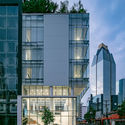
Morpholio Trace, the team who brought the architects’ canary yellow trace paper into the digital world, has been on a ten-year mission to help foster a drawing renaissance for Architects. “Drawing is a form of thought, and the iPad was crucial in re-centering sketching as a primary means of generating and sharing ideas,” says Mark Collins, Architectural Designer and Morpholio Co-Founder.
Today, ArchDaily celebrates this drawing resurgence with a look at those who have dedicated their careers to drawing exploration, advancement, and most importantly…education! To start drawing alongside these renowned architectural sketch educators, download Trace here.















.jpg?1520547289)

















